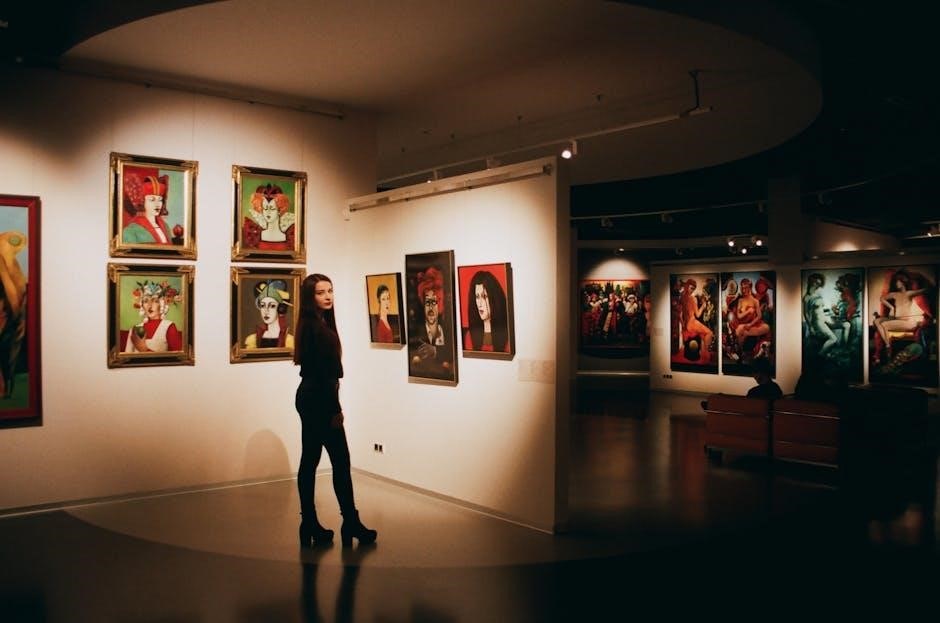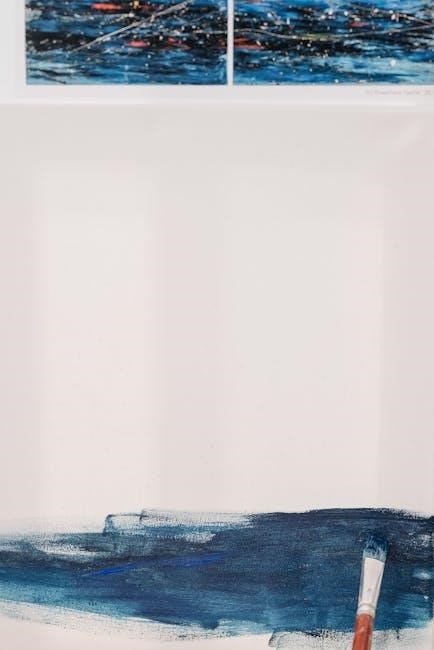This edition by Debra J. DeWitte, Ralph M. Larmann, and Kathryn Galitz emphasizes visual analysis, cultural contexts, and a student-centered approach. It integrates digital resources like InQuizitive and videos to enhance learning, fostering a deeper understanding of art history and techniques. The book bridges theory and practice, encouraging critical thinking and creative engagement, making it an essential resource for visual arts education.
Overview of the Book and Its Importance
Gateways to Art: Understanding the Visual Arts, Fourth Edition is a comprehensive textbook designed to foster critical thinking and visual literacy. It explores the elements of art, principles of design, and cultural contexts, offering a global perspective. The book’s student-centered approach, combined with digital resources like InQuizitive and videos, makes it an essential tool for art education. Its importance lies in its ability to connect theory with practice, providing learners with a deeper understanding of the visual arts and their significance in diverse societies and historical periods.
Authors and Their Contributions to Art Education
Debra J. DeWitte, Ralph M. Larmann, and M. Kathryn Galitz are renowned experts in art education. Their collaborative work on Gateways to Art has revolutionized visual arts education by integrating diverse perspectives and innovative pedagogical strategies. DeWitte’s expertise in art history and visual analysis, Larmann’s focus on studio practices, and Galitz’s insights into museum education create a holistic approach. Their contributions emphasize critical thinking, cultural awareness, and student engagement, making their text a cornerstone for educators and learners alike in understanding and appreciating the visual arts.
Key Features of the Fourth Edition
The fourth edition of Gateways to Art offers enhanced interactive learning tools, including InQuizitive, videos, and a student site with a museum journal. It provides a comprehensive exploration of art history, techniques, and cultural contexts, with updated examples and global perspectives. The edition emphasizes visual analysis, cross-referencing, and student-centered learning, making it a dynamic and engaging resource for visual arts education. Its integrated digital platform supports deeper understanding and active participation in the study of art.

The Visual World: Foundations of Art
The Visual World explores the elements of art—line, color, form, texture, and space—and the principles of design, providing a foundational understanding of visual composition and aesthetic expression.
The Elements of Art: Line, Color, Form, Texture, and Space
The elements of art—line, color, form, texture, and space—are the fundamental components used to create visual compositions. Line defines shape and movement, while color evokes emotions and perceptions. Form and texture add depth and tactility, and space organizes the composition. Together, these elements create balance and harmony, enabling artists to communicate ideas effectively. Understanding these basics is crucial for analyzing and interpreting artworks across cultures and historical periods, as they form the building blocks of visual expression and aesthetic experience.
The Principles of Design: Balance, Proportion, Rhythm, and Unity
The principles of design—balance, proportion, rhythm, and unity—guide the organization of artistic elements to create visually appealing compositions. Balance distributes visual weight, while proportion establishes size relationships. Rhythm creates movement through repetition, and unity ensures harmony among all elements. These principles enhance aesthetic appeal and guide the viewer’s eye, fostering engagement with the artwork. Understanding these concepts is essential for analyzing and creating art, as they provide a framework for effective visual communication and artistic expression.
Visual Analysis: Learning to Interpret Artworks
Visual analysis involves closely examining artworks to understand their composition, meaning, and cultural context. This process enhances critical thinking and observational skills, enabling students to interpret art effectively. By focusing on elements like line, color, and form, as well as principles of design, learners develop a deeper appreciation for artistic techniques and the stories behind the works. The book guides students through this process, fostering a nuanced understanding of visual language and its role in communication across cultures and historical periods.

Art Historical Periods and Movements
Exploring the evolution of art from ancient to contemporary periods, this section examines key styles, techniques, and cultural influences that shaped artistic movements across history.
Ancient to Medieval Art: Key Styles and Influences
This section explores the artistic developments from ancient civilizations to the medieval period, highlighting key styles such as Egyptian monumental sculpture, Greek classical ideals, Roman realism, and Byzantine mosaics. It examines the techniques and materials used, such as marble carving, fresco painting, and manuscript illumination. The influence of religious and cultural themes, like Early Christian symbolism and Islamic geometric patterns, is also discussed, revealing how these traditions laid the foundation for later artistic movements.
Renaissance to Modern Art: Evolution of Techniques and Ideas
From the Renaissance’s revival of classical ideals to modern art’s experimental forms, this section traces the evolution of techniques and ideas. It highlights the Renaissance’s mastery of linear perspective and humanist themes, the Baroque’s dramatic lighting, and the 19th century’s shift to Impressionism and Post-Impressionism. The 20th century’s movements, such as Cubism and abstraction, are explored, emphasizing artists like Picasso and Miró. The period reflects a transition from realism to conceptual expression, mirroring societal and cultural changes.
Contemporary Art: Global Perspectives and Innovations
Contemporary art reflects diverse global perspectives, blending cultural traditions with modern innovations. Digital art, installation, and mixed media challenge traditional boundaries, while artists address identity, technology, and social justice. Globalization fosters cross-cultural exchanges, enriching artistic expressions. The section highlights influential figures and movements, emphasizing art’s role in shaping cultural narratives. It underscores the dynamic evolution of visual arts, encouraging engagement with today’s interconnected world.
Media and Techniques in Art
Exploring diverse artistic mediums, from painting to sculpture, printmaking, photography, and digital art, this section examines materials, methods, and innovations, blending traditional practices with modern techniques to foster creativity.
Painting: Materials and Methods
Painting involves diverse materials like oils, acrylics, and watercolors, each with unique properties and techniques. Artists use brushes, palette knives, or even digital tools to apply paint on surfaces such as canvas or wood. Layering, glazing, and impasto are key methods that enhance texture and depth. This section explores the evolution of painting materials, from traditional mediums to contemporary innovations, offering insights into how artists achieve specific effects and express their creative vision through various painting practices and styles.
Sculpture: From Traditional to Contemporary Practices
Sculpture explores three-dimensional art through diverse materials and techniques. Traditional practices include carving, casting, and assembling, using materials like marble, bronze, and wood. Contemporary artists experiment with steel, plastics, and found objects, pushing boundaries with welding, 3D printing, and mixed media. This section examines the evolution of sculptural methods, from classical forms to modern innovations, highlighting how artists use these techniques to express ideas, challenge norms, and engage with cultural and historical contexts, transforming physical space into meaningful artistic experiences.
Printmaking, Photography, and Digital Art
Printmaking involves transferring images from a matrix to paper, using techniques like etching, lithography, and screen printing. Photography captures reality through light and composition, evolving from film to digital. Digital art uses software to create and manipulate images, enabling innovative visual expressions. These mediums expand artistic possibilities, blending traditional craftsmanship with modern technology. They offer unique ways to explore themes, textures, and ideas, making them integral to contemporary artistic practice and education, as highlighted in the fourth edition of Gateways to Art.

Cultural and Historical Contexts
Art reflects society’s values, traditions, and beliefs, shaped by historical events and cultural identity. Understanding these contexts enriches the interpretation of artistic expression and its purpose.
Art as a Reflection of Society and Culture
Art serves as a mirror to society, capturing its values, traditions, and cultural identity. It reflects the beliefs and social structures of different eras and regions. By analyzing artworks, one can understand historical contexts, such as the Renaissance celebrating humanism or 19th-century art responding to industrialization. This connection highlights art’s role in documenting and influencing cultural evolution, making it a vital tool for understanding human experiences across time and place.
Religious and Spiritual Themes in Art
Religious and spiritual themes in art serve as powerful expressions of faith, belief, and transcendence. From sacred icons to ritualistic imagery, art has long communicated spiritual ideas and values. It often employs symbols, such as the cross in Christianity or the lotus in Buddhism, to convey deeper meanings. These works not only reflect the cultural and theological contexts of their creation but also inspire devotion and introspection. The fourth edition of Gateways to Art explores how such themes resonate across cultures, connecting art to the human quest for meaning and the divine.
Political and Social Movements in Art History
Art has long served as a powerful medium for expressing political and social movements, reflecting the cultural and ideological shifts of their time. From the revolutionary iconography of the Mexican Muralists to the protest art of the Civil Rights era, artists have used their work to challenge authority, advocate for justice, and inspire change. The fourth edition of Gateways to Art examines how these movements influenced artistic styles and themes, emphasizing art’s role in shaping societal consciousness and fostering dialogue about human rights and equality.

Global Perspectives in Art
This section explores art traditions from diverse cultures, emphasizing cultural diversity and global influences, while showcasing how art reflects and connects different societies worldwide effectively.
African, Asian, and Indigenous Art Traditions
This section delves into the rich artistic traditions of African, Asian, and Indigenous cultures, exploring their unique styles, symbols, and cultural significance. From the intricate carvings of African Yoruba art to the spiritual imagery of Buddhist mandalas, the text highlights how these traditions reflect local beliefs, histories, and environments. Indigenous art, such as Australian Aboriginal dot paintings, is also examined for its connection to land and ancestry. The chapter emphasizes the importance of understanding these diverse traditions within the broader context of global art history, fostering cross-cultural appreciation and awareness.
European and American Art: Comparative Analysis
This section explores the evolution of European and American art, highlighting key movements and influences. From the Renaissance to modernism, the text compares stylistic developments, cultural contexts, and historical narratives; European art is examined for its technical mastery and thematic depth, while American art is discussed in terms of its unique identity and cultural synthesis. The chapter emphasizes the dialogue between tradition and innovation, illustrating how these artistic traditions have shaped global visual culture and continue to influence contemporary practices.
Modern and Contemporary Art from Diverse Cultures
This section highlights the global perspectives of modern and contemporary art, emphasizing works from diverse cultures worldwide. It explores how artists from Africa, Asia, Latin America, and beyond contribute to the global art dialogue. The chapter discusses themes such as identity, globalization, and cultural hybridity, while showcasing innovative mediums like digital art and installations. By connecting these works to historical and cultural contexts, the text fosters an appreciation for the richness and complexity of contemporary artistic expression across the globe.
Themes and Symbols in Art
Exploring themes like nature, human experience, and abstraction, this section examines how symbols convey meaning and ideas across cultures, enriching visual storytelling and interpretation.
Nature, Human Experience, and Abstraction
Nature, human experience, and abstraction are central themes in art, reflecting emotions, ideas, and the world. Artists use natural forms and abstract elements to explore existential questions, creating works that resonate deeply with viewers. These themes encourage introspection and connection, bridging the personal and universal. Through abstraction, art communicates complex ideas visually, while nature-inspired pieces often highlight humanity’s relationship with the environment. This interplay of themes enriches understanding and fosters emotional and intellectual engagement with artworks.
Mythology and Narrative in Art
Mythology and narrative have long been central to art, serving as powerful tools to convey stories, beliefs, and cultural values. Artists often draw from mythological themes to explore universal truths and moral lessons. Narrative art, through compositions and symbols, engages viewers in storytelling, creating emotional connections. These elements help decode meanings, bridging the gap between the artwork and its audience. Mythology and narrative continue to inspire artists, offering rich sources of inspiration and deeper layers of interpretation in visual arts.
Symbolism and Iconography Across Cultures
Symbolism and iconography are integral to understanding cultural identities and artistic expression. Symbols carry layered meanings, often rooted in cultural, religious, or historical contexts. Iconography involves the study of images and their significance, revealing societal values and beliefs. Across cultures, symbols like the cross or yin-yang represent universal themes. Artworks often blend personal and collective symbols, creating rich narratives. Decoding these elements enhances interpretation, bridging cultural gaps and fostering deeper connections to the artistic traditions they represent; This visual language transcends words, speaking directly to human experience and shared heritage.

Art in Context: Museum and Gallery Projects
This section explores how museums and galleries serve as dynamic spaces for engaging with art. It emphasizes hands-on learning through interactive projects and digital resources, fostering a deeper connection to artworks and their cultural contexts.
The Role of Museums in Art Education
Museums play a pivotal role in art education by providing interactive and immersive learning experiences. They offer access to original artworks, enabling students to analyze and interpret pieces firsthand. Through guided tours, workshops, and digital resources, museums foster critical thinking and creativity. The book highlights how museums facilitate engagement with diverse cultural and historical contexts, making art accessible and meaningful for learners of all levels. This hands-on approach complements classroom studies, enriching students’ understanding of visual arts and their significance in society.
Engaging with Art in Galleries and Exhibitions
Engaging with art in galleries and exhibitions fosters a deeper connection to visual arts through interactive and immersive experiences. The Fourth Edition emphasizes the importance of these spaces for hands-on learning and critical analysis. Students can participate in guided tours, interactive activities, and digital tools like InQuizitive to enhance their understanding. Galleries provide a dynamic environment for exploring diverse artworks, encouraging students to apply their knowledge of art elements and principles. This direct interaction with art supports visual literacy and fosters a lifelong appreciation for creative expression.
Student-Centered Learning Through Museum Projects
Student-centered learning through museum projects encourages active participation and critical thinking. The Fourth Edition integrates digital tools like the Museum Journal, enabling students to document and reflect on their experiences. Interactive activities and guided projects allow learners to analyze artworks, fostering a deeper understanding of cultural and historical contexts. By engaging directly with museum collections, students develop practical skills in visual analysis and interpretation, bridging the gap between theory and real-world application. This approach promotes creativity, collaboration, and a personalized learning experience tailored to individual interests and needs.

Gateways to Art: Digital Resources and Tools
The Fourth Edition offers InQuizitive, videos, and the Museum Journal, enhancing engagement with interactive learning and digital tools for a dynamic educational experience.
Interactive Learning with InQuizitive and Videos
InQuizitive and accompanying videos in the Fourth Edition provide dynamic, interactive learning experiences. These tools enhance understanding of key concepts, offering immersive engagement with art history, techniques, and cultural contexts. Videos complement textual content, while InQuizitive challenges students to apply knowledge through activities, fostering critical thinking and retention. These resources cater to diverse learning styles, making complex ideas accessible and engaging for students in visual arts education.
The Student Site and Museum Journal: Enhancing Engagement
The Student Site and Museum Journal expand learning opportunities, offering curated resources and interactive tools. The Museum Journal encourages students to document and reflect on gallery visits, fostering deeper connections with artworks. These digital platforms complement coursework, providing a space to explore art historically and critically. By integrating these resources, students engage actively with visual arts, enhancing their understanding and appreciation of diverse artistic traditions and contemporary practices.
Technology and Innovation in Art Education
Technology enhances art education through interactive tools like InQuizitive and videos, providing dynamic learning experiences. The Fourth Edition integrates digital resources to engage students, offering exclusive content for visual analysis and art historical exploration. These innovations facilitate a deeper understanding of artistic techniques and cultural contexts, making complex concepts more accessible; By leveraging technology, the textbook encourages active learning and fosters a connection between traditional and contemporary art practices, preparing students for the evolving landscape of visual arts education.
The future of visual arts education lies in innovation, accessibility, and student-centered approaches. Digital tools like InQuizitive and interactive videos redefine learning, fostering creativity and cultural understanding.
Emerging Trends in Art Education
Emerging trends in art education emphasize technology integration, personalized learning, and interdisciplinary approaches. Tools like InQuizitive and interactive videos enhance engagement, while global perspectives broaden cultural understanding. The Fourth Edition highlights these innovations, fostering critical thinking and creativity. Digital platforms now enable immersive learning experiences, making art education more accessible and inclusive. These trends reflect a shift toward dynamic, student-centered methodologies, preparing learners for an evolving artistic landscape.
The Role of Students in Shaping Art’s Future
Students play a pivotal role in shaping the future of art by engaging with diverse perspectives and innovative tools. The Fourth Edition of Gateways to Art encourages active participation through interactive resources like InQuizitive and videos, fostering creativity and critical thinking. By analyzing artworks and exploring cultural contexts, students develop a deeper understanding of artistic traditions and contemporary practices. Their interpretations and creative contributions help evolve art’s global narrative, ensuring its relevance and vibrancy for future generations.
Gateways to Art as a Catalyst for Lifelong Learning
Gateways to Art serves as a catalyst for lifelong learning by providing students with foundational knowledge and critical thinking skills to engage with the visual arts. The Fourth Edition’s interactive tools, such as InQuizitive and videos, encourage active learning and exploration. By fostering a deeper understanding of art’s cultural, historical, and global contexts, the text inspires students to continue exploring and interpreting art beyond the classroom, making it a valuable resource for both academic and personal growth in visual arts education.

Leave a Reply
You must be logged in to post a comment.